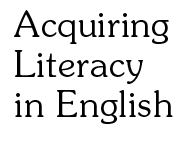Acquiring Literacy in English:
Crosslinguistic, Intralinguistic, and Developmental Factors
Narrative Production Task
Author and Date
Patton Tabors and Mariela Páez, formerly of the Harvard Graduate School of Education, and Center for Applied Linguistics. 2002.
Purpose
The English and Spanish versions of the Narrative Production Task were designed to assess children’s oral proficiency in English and Spanish, respectively. The tests were developed for the research study Early Childhood Study of Language and Literacy Development of Spanish-speaking Children, subproject 1 of Acquiring Literacy in English: Crosslinguistic, Intralinguistic, and Developmental Factors.
Age or Grade of Examinees
The assessments were developed to be used with children ages 3-8.
Description
The Narrative Production Task is an oral elicitation assessment based on three pictures of the adventures of a family having a picnic in a park. Children’s oral responses are recorded, transcribed, and coded.
Administration
English: A native English-speaking researcher shows the three pictures to the child and says: “I want you to look at the pictures as long as you want and then I am going to take them away. After I take them away, I want you to tell me a story of what happened in the pictures.” The researcher then encourages the child to tell a story about the pictures he/she just saw.
Spanish: A native Spanish-speaking researcher shows the three pictures to the child and says: “Quiero que los mires por el tiempo que quieras y luego los voy a guardar. Cuando los guarde, quiero que me digas una historia de lo que pasó en los dibujos.” The researcher then encourages the child to tell a story about the pictures he/she just saw.
In both cases, the task is finished when the child declares that the story is finished. The researcher records the child’s response and trained coders listen to and count the number of words in the child’s response.
Scoring and Interpretation
The child’s score is the number of words that he/she uses in telling the family picnic story. Previous research has shown that the number of words in children’s stories is related to the complexity of children’s language. In turn, language complexity is related to later school success (Snow & Tabors, 1993).
Reliability and Validity
Reliability and validation data pending.
Sources
The Narrative Production Task (Spanish and English) was based on research conducted by Snow, Tabors, and others.
Snow, C. E, & Tabors, P. O. (1993). Language skills that relate to literacy development. In Spodek, B. & Saracho, O. (Eds.), Yearbook in Early Childhood Education, 4. New York, NY: Teachers College Press.
Snow, C., Tabors, P., Nicholson, P., & Kurland, B. (1995). SHELL: A method for assessing oral language and early literacy skills in kindergarten and first grade children. Journal of Research in Childhood Education, 10 (1), 37-48.
Availability
The Narrative Production Task materials are available from the Center for Applied Linguistics. To request a copy, complete and submit the Application Form for Use of ALE Researcher-developed Assessment Instruments, available in Microsoft Word and Adobe PDF format.
Citation
Researchers using the Narrative Production Task should cite it as follows:
Harvard Graduate School of Education and Center for Applied Linguistics. (2002). Narrative Production Task—English. Washington, DC: Center for Applied Linguistics.
Harvard Graduate School of Education and Center for Applied Linguistics. (2002). Narrative Production Task—Spanish. Washington, DC: Center for Applied Linguistics.
Return to the list of researcher-developed assessments.

